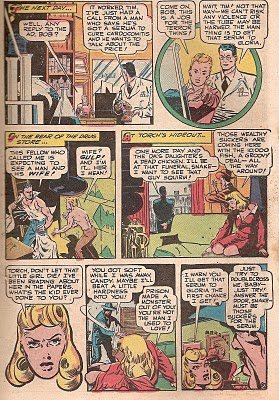The contents of comic reflect the publisher's confusion. Inside is an 8-page Judy of the Jungle story "The Deadly Triangle" by Ralph Mayo, this 10-page Black Terr story "The Deadly Choice" with art by Mort Lawrence, a three-page text story called "King of the Chimpanzees" by Charles S Strong and masthead art by Ralph Mayo, a one-pager gag called Zippy by Al Hartley, an eight-page Roger Dodger story by Art Gates, a story with Rick Howard, the Mystery Rider by a mystery artist, a 2-page "how-to" called Junior Judo, subtitled "Another Real Lesson in Judo" by and the last story is the last appearance ever of Strut Simmons in a 7-page story by Ed Good.
A side note about Mort Lawrence, who probably drew this Black Terror story. He is best known for his work on Atlas Comics' Young Men series (1953–1954) which reintroduced Captain America and Bucky as communist hunting super-heroes. He does a respectable job on this story, and I especially like the final two panels. You can see more of Lawrence's work here.
Here's the summary of "The Deadly Choice": A crime boss named Torch is released after five years of jail time and, despite the pleas from his girlfriend Candy, is determined to get his revenge on the D.A. who put him away. He hears the D.A.'s little girl has a rare disease called Cardocomitis, and plans to steal the girl's medicine. Fortunately for the D.A. and his daughter, pharmacist Bob Benton (aka The Black Terror), and his assistant Tim (aka Tim), are delivering the Cardocin medicine.
The thugs break in and grab the medicine. To avoid further danger to the DA and his daughter Bob and Tim let the thieves go, but as soon as they're clear the Terror Twins burst into action. I love the panel where they're crashing through the D.A.'s front door. This is the panel that shows of their powers the most, unfortunately they aren't in costume.
The thugs get away, and Bob decides to run an ad in the paper offering $10,000 to anyone who can provide some Cardomicin serum. Time is short, the girl can't last more than 3 days without her medicine, but luckily Torch answers the ad. For the meeting with the crime boss, Bob and Tim pose as an aging industrialist and his wife and pay a visit to the gangsters.
A fight ensues (still not in costume) and in the confusion Candy grabs the medicine in an effort to take it to the D.A.'s daughter. The chase ends up at the railroad yards where Torch tries to shoot his girlfriend. Candy pulls her own gun. "Don't make me do it, Torch," she says. "Ugh! I didn't thing you'd..." he replies.
The final two panels are my favorite in the story: "It'll be hard for a while, Candy-- but you'll forget." Says the Black Terror to Candy."Some day you'll be able to live the kind of life you really want."
"And you saved a kid's life..." adds Tim.
Reflecting the movement away from superheroes, this story is also a microcosm of the passage from superheroes in the 40's to the gangster comics in the 50's.The Terror Twins are hardly ever in costume, and show almost none of their powers. Except for the pharmacist angle, this story could have had Mickey Spillane characters rather than superheroes.
There's an emphasis on gangster dialogue, so much that it's almost annoying. Note the 6th panel of the 2nd page where the thug says "r-e-e-t" or during the fight scene on page 6 "pardon my boardin' house reach, toots!"
Unlike the earlier Black Terror stories, Jean is nowhere to be found. The leading lady is clearly Candy. She's drawn as if draped over the page, sultry, bad, yet trying so hard to be good.
I thought the caricatures were much more pronounced in these stories, almost in the style of Will Eisner or Jack Cole. Take, for example, The Torch's right-hand man Snake. Also, the artist took seemed to have a lot of fun drawing Candy throughout the story, and also the scenes when Bob and Tim are posing as the industrialist and his wife. Note, too, the curve of the car as it moves across the traintracks in the 3rd to last page.











No comments:
Post a Comment